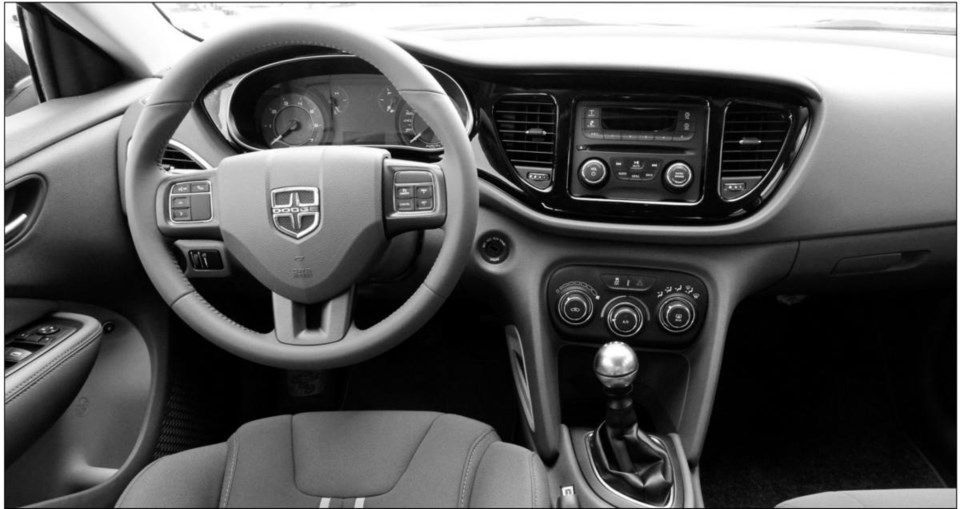The arrival of the 2013 Dodge Dart at Chrysler dealerships heralds the second product of a marriage between Chrysler and Fiat.
When the first child, the two-door hatchback Fiat 500 subcompact, came to North America, it retained much of its European character.
Not so with the Dart. Although it started life in Europe as the Alfa Romeo Giulietta, Chrysler gave it a name from the company's past and made the front-wheel-drive platform longer and wider to accommodate North American tastes.
The result is a contemporary compact four-door sedan that doesn't look out of place parked beside competitors such as the Honda Civic, Ford Focus, Chevrolet Cruze and Toyota Corolla.
Chrysler lately has been keen on resurrecting old names - and the history they conjure. The Challenger, Charger and now the Dart evoke pleasant memories of Chrysler's more successful models.
But it's one thing to give a new child an old name; it's another to engineer a car to take on what is arguably one of the most hotly contested vehicle segments in the market.
Fortunately, the new Dart has good genes. In Europe, the Giulietta is known for its handling and comfort, and those traits continue in the Dart. Built wider and longer, it appeals to a larger segment of the market here as well.
There are five models, starting from $15,995 for the SE up to $23,995 for the R/T. We drove a middle-ofthe-road Rallye with a list price of $19,495.
The most expensive option on our car was a charge of $1,300 for a 1.4-litre turbo that replaces the stock 2.0-litre four-cylinder. Performance-hungry buyers can upgrade to a 2.4-litre in the R/T model.
The turbocharged 1.4-litre four-cylinder is the same engine found in the Fiat 500 Abarth. It produces an impressive 160 hp and 184 lb.-ft. of torque and is mated to a six-speed manual transmission. A doubleclutch automatic - also sixspeed - is available as an option.
The powerplant is very smooth, with the ability to freely spin all the way to redline without any vibration or roughness. While the power is there, it's important to choose the right gear. A few times when I tried to accelerate in too high a gear, I barely felt a difference.
The sweet spot, I found out later, was to get the engine revs between 2,500 and 4,000 r.p.m., where the 184 lb.-ft. of torque peaks.
There are no official 0-100 km/h times, but I would wager the 1.4-litre Dart won't be the engine of choice for those with a need for speed. So don't expect much power, but great fuel economy in the top two gears.
Economy-minded buyers will immediately take a shine to the Dart's Transport Canada ratings. It says the 1.4-litre turbo returns a 4.9 litre/100 km fuel-consumption figure on the highway and 7.4 in the city. Those numbers are impressive. For example, the Honda Civic, with a 1.8-litre and five-speed transmission, gets 5.4 and 7.4, respectively, and it's a smaller car.
But the transmission could use a bit more refinement. The throws between gears are long. The clutch, while light, likewise has a long travel. But those are minor quibbles compared to the challenges posed by the cabin ergonomics. The Dart has a centre armrest between the seats. Unfortunately, when shifting from first to second gear, it gets in the way of the driver's elbow. I had to lift my elbow off to the right side to avoid continually whacking it.
Another pet peeve is a smallish dead foot rest - it's just too small to brace one's foot against. Come winter, with snow boots, it will even get worse.
The cabin is a step up from the Dodge Caliber, which it replaces, with decent fabrics and materials. There are thoughtful cubbyholes, and the glove box can almost swallow a shoe box. There was also a small storage bin hidden under the front passenger seat.
The back seats are decent, but don't torture an adult by making him or her sit for any period of time in the centre. The Dart has a ski passthrough between the rear seats, a feature not usually found in this price range. The rear seat-back folds 60/40, but the resulting surface is not flat. I didn't notice any cupholders in the back, either.
Attractive twin oval pipes (which sound great) and a back end that shares design cues with the larger Charger finish off the styling of the Dart.
The Dart is an excellent addition to the Dodge family. While some may decry its European paternity, others will argue that the infusion of world-class DNA into North American cars can only make them stronger. It's anybody's guess whether junior will one day hit a home run, but nothing in its genes will hold it back.
THE SPEC SHEET
Type: Compact four-door-sedan, front engine, front-wheel-drive
Engine: Turbocharged 1.4-litre fourcylinder engine, 160 hp at 6,400 r.p.m. and 184 lb.-ft. of torque at 2,500 to 4,000 r.p.m.
Transmission: Six-speed manual
Dimensions (mm): Length, 4,672; width, 1,830; height, 1,465; wheelbase, 2,703
Curb weight (kg): 1,439
Price (base/as tested): $19,495/$23,140 (includes $1,500 destination and PDI and $100 AC tax)
Options: 1.4-litre turbo $1,300, UConnect $350, metallic paint $100
Tires: 225/45 R17 on alloy wheels
Fuel type: Regular
Fuel economy (L/100km): 7.4 city/ 4.9 highway
Warranty: Three years/60,000 km new car, five years/100,000 km powertrain and roadside assistance



